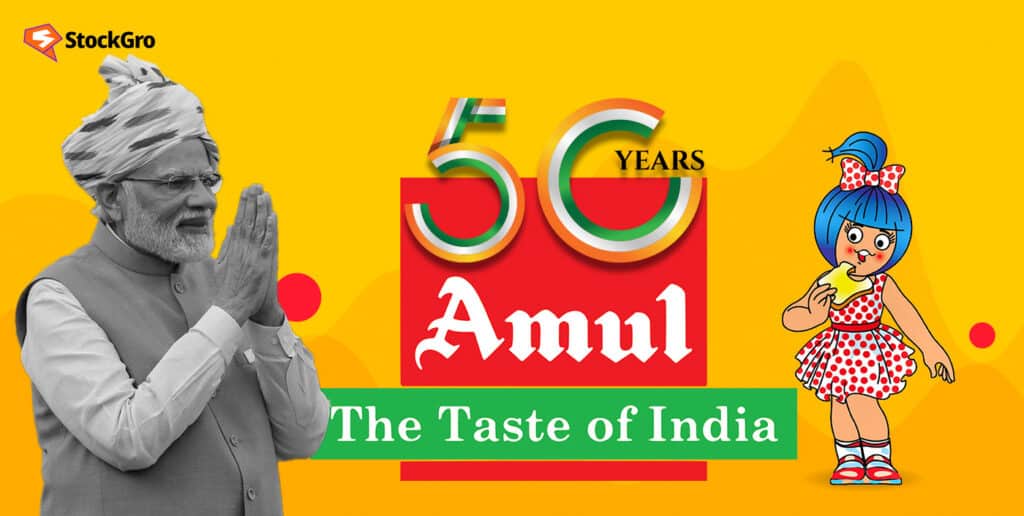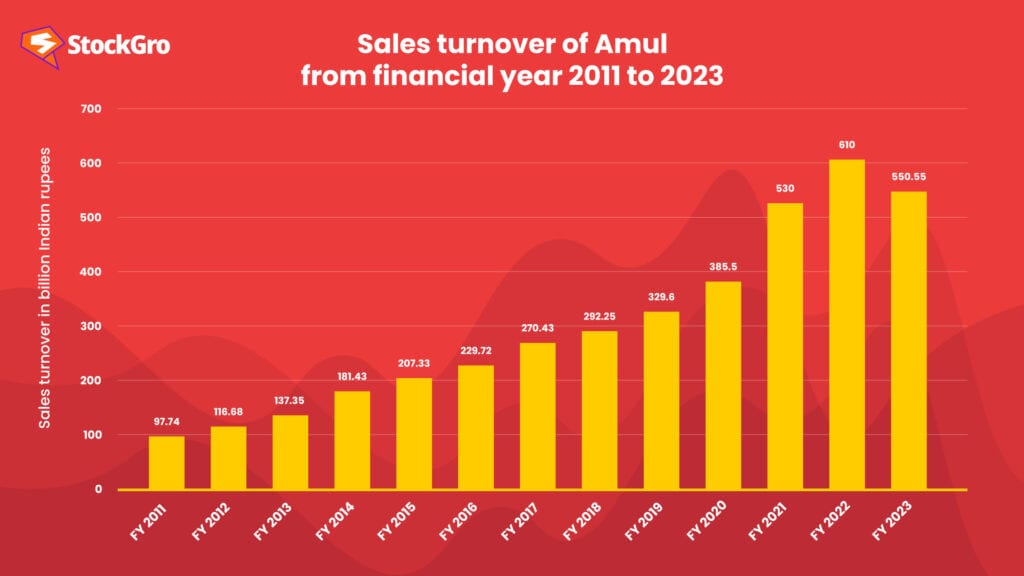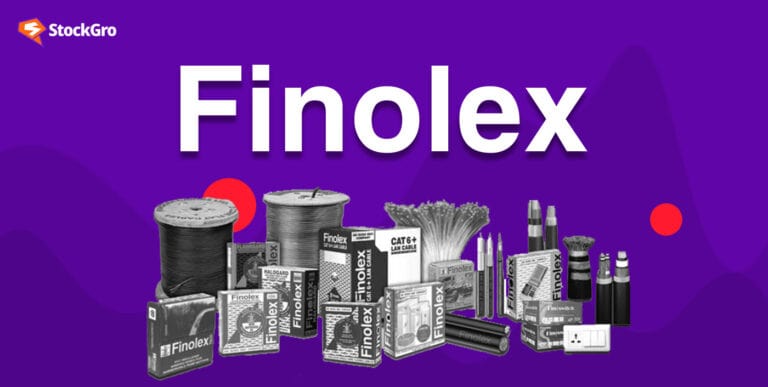
Amul has been the epitome of India’s cooperative movement since its inception in 1946. What started as a small dairy cooperative in Anand, Gujarat, is today a $9 billion brand. From a small dairy cooperative owned by farmers to a leading Indian brand, Amul’s growth has been exceptional.
As PM Modi joins the Golden Jubilee celebration, this article analyses the exemplary Amul case study – its cooperative structure, product portfolio spanning milk to ice creams, competition with giants like Nestle, and roadmap for 20% growth.
About Amul (Anand Milk Union Limited)
Amul was established in 1946 and is now run by the Gujarat Cooperative Milk Marketing Federation Ltd. (GCMMF), a cooperative organisation that includes 3.6 million milk farmers in Gujarat.
The Amul concept is based on a cooperative structure with three levels. The organisation’s milk supply begins at the bottom with thousands of milk producers, most of whom are farmers.
The GCMMF, which is in charge of packaging, processing, advertising, and shipping, represents the cooperative society at the next tier. Thirdly, there is the retail channel network that distributes Amul’s dairy products to customers and merchants.
This approach focuses on cutting costs, keeping an eye on quality, growth that benefits everyone, and establishing a brand. The cooperative structure of Amul allows for the sale of a variety of dairy products at reasonable prices, which in turn empowers farmers and generates revenue.
More than 550 billion rupees were reported as sales by Amul in the fiscal year of 2023. Amul, or Anand Milk Union Limited, has been steadily expanding since 2011, making it one of the world’s largest dairy corporations.
The annual growth rate of India’s domestic milk consumption volume has been at least 2% since 2019. In the previous fiscal year, the value of the domestic organised ice cream sector surpassed ₹9,000 crore, where the market share of Amul in India was the greatest.
Here’s a quick rundown of the Gujarat Cooperative Milk Marketing Federation Ltd. (GCMMF)

Also read: Varun Beverages Ltd.
PM Modi in Gujarat to unveil ₹22,000 crore projects: Amul’s golden jubilee celebration
On February 22, at Narendra Modi Stadium in Ahmedabad, Prime Minister Shri Narendra Modi was a guest at the Gujarat Cooperative Milk Marketing Federation’s Golden Jubilee ceremony.
The Prime Minister emphasised that, with a massive market share of Amul, the company stood out among the numerous brands that came to prominence in India after independence.
There have been 23 milk companies in Gujarat, up from 12 in the previous 20 years. More than 36 lakh individuals have found work in the dairy business; among them, 11 lakh are women.
By pointing to the Mudra Yojana, which has provided aid to almost 70% of women and amounts to more than ₹30 lakh billion, he showed how the government is making efforts to empower women economically.
The dairy industry in India is growing at a rate of 6% per year, according to Modi, compared to 2% worldwide. The government is ready to provide full assistance for Amul to become number one worldwide, which is now the eighth-biggest dairy firm in the world.
Prime Minister Modi visited Amul’s golden jubilee to announce projects for development valued at over ₹22,850 crore.
These projects would cover 15 districts and include vital areas like roads, rail, electricity, healthcare, urban planning, water distribution, and tourism. As part of this, the Surat Municipal Corporation, the Surat Urban Development Authority, and Dream City all had projects worth more than ₹5,040 crore inaugurated and foundation stones laid.
The Prime Minister will also reveal 50 electric buses, with a combined cost of ₹840 crore, as well as components of the Tapi Purification Project and DREAM City Limited’s projects, with a combined cost of ₹597 crore and ₹49 crore, respectively.
Business model of Amul
Here are some of the ways Amul generates revenue by working with a cooperative model.
- Revenue from dairy goods
The sale of Amul’s many dairy products is the company’s primary source of profit. Amul sells its products online and via a wide variety of distribution points, including conventional shops, grocery stores, Amul-only stores, and online.
- Franchises and licencing
Under Amul’s licencing and franchising strategy, other parties are granted the right to sell Amul goods under the Amul brand name, subject to specific terms and limitations. One source of income for Amul comes from these agreements in the form of royalties and licencing fees.
- Managed production
As a contract manufacturer, Amul produces dairy goods for other companies and brands. By entering into these contracts, Amul allows other parties to use its manufacturing facilities and capacities to make dairy products.
- Supporting services
To back up those involved in the dairy business, Amul provides additional support services. Dairy cooperatives and other related organisations get packaging supplies, machinery, and expert advice as part of these services.
Amul’s competitors
Some of Amul’s main competitors are Mother Dairy, Nestle India, and Britannia Industries. While Mother Dairy is an unlisted company, the market capitalisation (₹ cr.) as of February 23, 2024, for Nestle India and Britannia Industries Ltd. is 248,487 and 119,410, respectively.
Also read: Mumbai High: ONGC’s legacy and future in India’s energy sector
Future outlook
The Gujarat Cooperative Milk Marketing Federation, which aims to grow by more than 20% in the coming years, sells milk products under the Amul brand. To achieve this goal, the organisation has decided to expand into 6–8 additional categories and invest around ₹5000 crores.
With the present rate of turnover, which is about $9 billion, Amul has to look for several billion-dollar segments to grow Amul’s business results through available opportunities.
According to Amul’s Managing Director, Jayen Mehta, the transition from unorganised to organised and branded goods in India, particularly after the pandemic, is the reason for the trust in Amul’s success.
Amul intends to increase production from its present 270 lakh litres per day to over 500 lakh litres daily in a couple of years, based on its capacity of about 450 lakh litres per day.
In the long run, the plan is to make Amul more of a household name in the fast-moving consumer goods industry, increase sales by 20% to 66,000 crore rupees in FY24, and reach 1 lakh crore rupees in sales by 2025.
Also read: Fast-Moving Consumer Goods (FMCG) Sector- A Safe Haven in Bear Markets?
Conclusion
Amul provides a template for equitable farmer-owned businesses via cooperative principles. With rising revenues and market share, planned forays into new FMCG segments, and continued support for milk producers, Amul is set for rapid expansion.
Though big brands compete, Amul keeps strengthening its farmer base and cooperative spirit, which makes Amul an inspiring case study.
